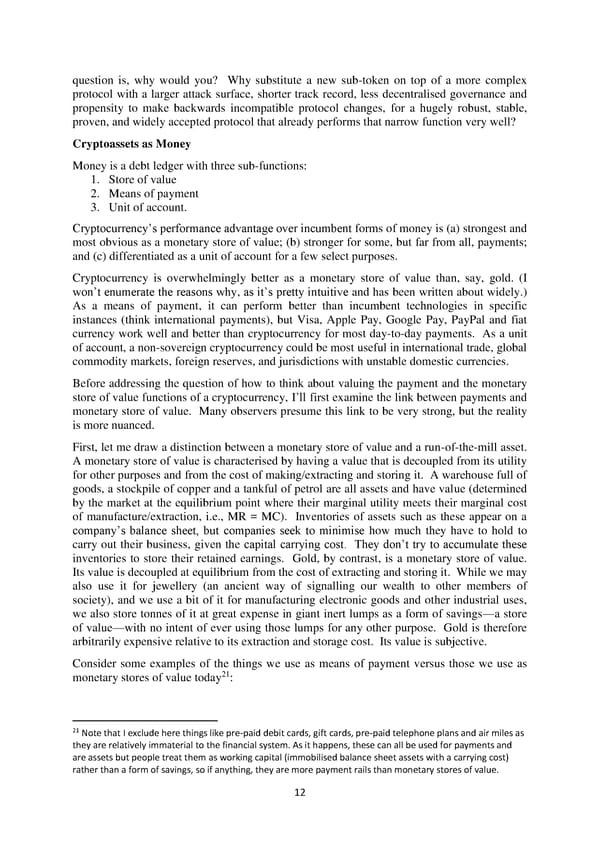question is, why would you? Why substitute a new sub-token on top of a more complex protocol with a larger attack surface, shorter track record, less decentralised governance and propensity to make backwards incompatible protocol changes, for a hugely robust, stable, proven, and widely accepted protocol that already performs that narrow function very well? Cryptoassets as Money Money is a debt ledger with three sub-functions: 1. Store of value 2. Means of payment 3. Unit of account. Cryptocurrency’s performance advantage over incumbent forms of money is (a) strongest and most obvious as a monetary store of value; (b) stronger for some, but far from all, payments; and (c) differentiated as a unit of account for a few select purposes. Cryptocurrency is overwhelmingly better as a monetary store of value than, say, gold. (I won’t enumerate the reasons why, as it’s pretty intuitive and has been written about widely.) As a means of payment, it can perform better than incumbent technologies in specific instances (think international payments), but Visa, Apple Pay, Google Pay, PayPal and fiat currency work well and better than cryptocurrency for most day-to-day payments. As a unit of account, a non-sovereign cryptocurrency could be most useful in international trade, global commodity markets, foreign reserves, and jurisdictions with unstable domestic currencies. Before addressing the question of how to think about valuing the payment and the monetary store of value functions of a cryptocurrency, I’ll first examine the link between payments and monetary store of value. Many observers presume this link to be very strong, but the reality is more nuanced. First, let me draw a distinction between a monetary store of value and a run-of-the-mill asset. A monetary store of value is characterised by having a value that is decoupled from its utility for other purposes and from the cost of making/extracting and storing it. A warehouse full of goods, a stockpile of copper and a tankful of petrol are all assets and have value (determined by the market at the equilibrium point where their marginal utility meets their marginal cost of manufacture/extraction, i.e., MR = MC). Inventories of assets such as these appear on a company’s balance sheet, but companies seek to minimise how much they have to hold to carry out their business, given the capital carrying cost. They don’t try to accumulate these inventories to store their retained earnings. Gold, by contrast, is a monetary store of value. Its value is decoupled at equilibrium from the cost of extracting and storing it. While we may also use it for jewellery (an ancient way of signalling our wealth to other members of society), and we use a bit of it for manufacturing electronic goods and other industrial uses, we also store tonnes of it at great expense in giant inert lumps as a form of savings—a store of value—with no intent of ever using those lumps for any other purpose. Gold is therefore arbitrarily expensive relative to its extraction and storage cost. Its value is subjective. Consider some examples of the things we use as means of payment versus those we use as 21 monetary stores of value today : 21 Note that I exclude here things like pre-paid debit cards, gift cards, pre-paid telephone plans and air miles as they are relatively immaterial to the financial system. As it happens, these can all be used for payments and are assets but people treat them as working capital (immobilised balance sheet assets with a carrying cost) rather than a form of savings, so if anything, they are more payment rails than monetary stores of value. 12
 Investor’s Take on Cryptoassets by John Pfeffer Page 11 Page 13
Investor’s Take on Cryptoassets by John Pfeffer Page 11 Page 13